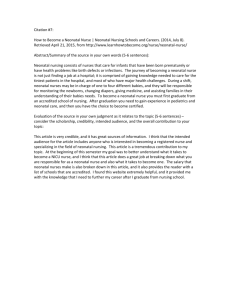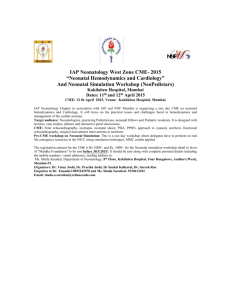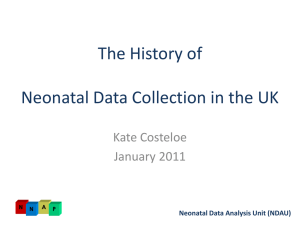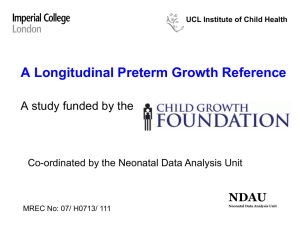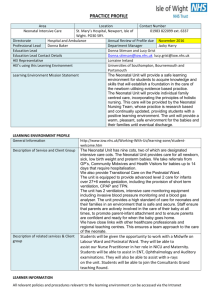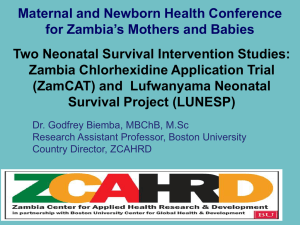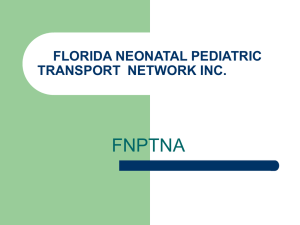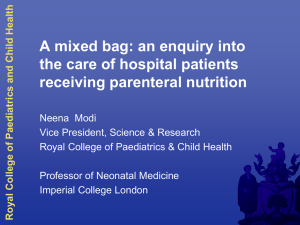COURSE DESCRIPTION This course provides
advertisement
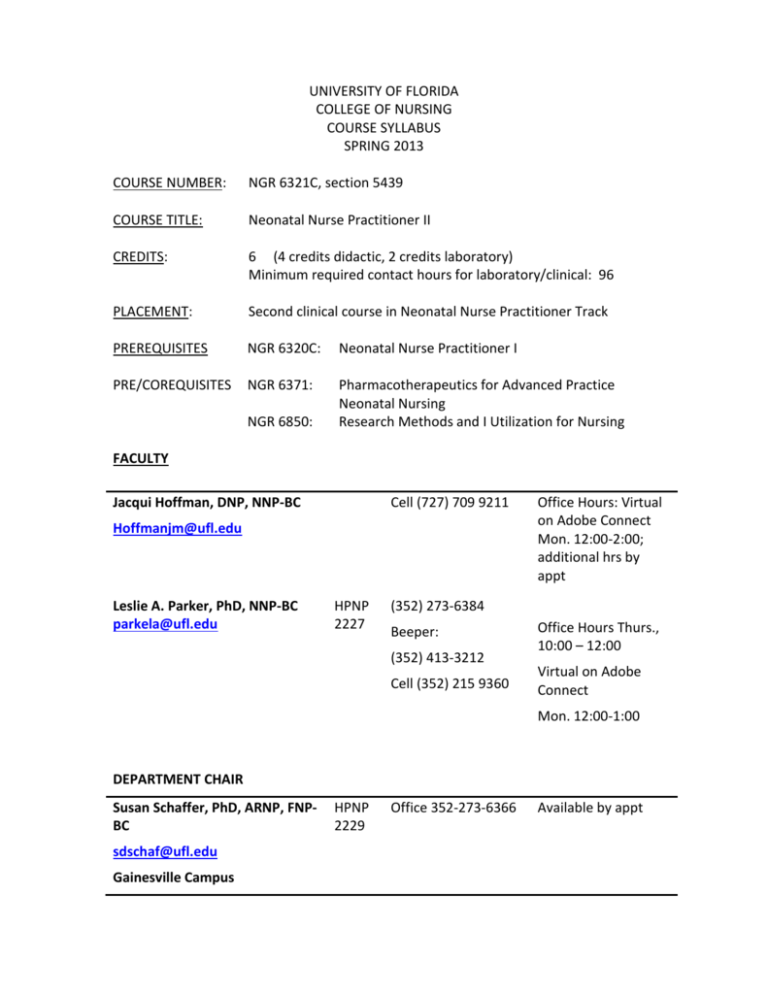
UNIVERSITY OF FLORIDA COLLEGE OF NURSING COURSE SYLLABUS SPRING 2013 COURSE NUMBER: NGR 6321C, section 5439 COURSE TITLE: Neonatal Nurse Practitioner II CREDITS: 6 (4 credits didactic, 2 credits laboratory) Minimum required contact hours for laboratory/clinical: 96 PLACEMENT: Second clinical course in Neonatal Nurse Practitioner Track PREREQUISITES NGR 6320C: Neonatal Nurse Practitioner I PRE/COREQUISITES NGR 6371: Pharmacotherapeutics for Advanced Practice Neonatal Nursing Research Methods and I Utilization for Nursing NGR 6850: FACULTY Jacqui Hoffman, DNP, NNP-BC Cell (727) 709 9211 Hoffmanjm@ufl.edu Leslie A. Parker, PhD, NNP-BC parkela@ufl.edu HPNP 2227 Office Hours: Virtual on Adobe Connect Mon. 12:00-2:00; additional hrs by appt (352) 273-6384 Beeper: (352) 413-3212 Cell (352) 215 9360 Office Hours Thurs., 10:00 – 12:00 Virtual on Adobe Connect Mon. 12:00-1:00 DEPARTMENT CHAIR Susan Schaffer, PhD, ARNP, FNPBC sdschaf@ufl.edu Gainesville Campus HPNP 2229 Office 352-273-6366 Available by appt CAMPUS DIRECTOR JAX Andrea Gregg, DSN, RN JAX Office: 904-244-5172 Associate Professor LRC, 3rd Floor Fax: 352-273-6568 greggac@nursing.ufl.edu Jacksonville Campus Available by appt COURSE DESCRIPTION This course provides advanced study of neonatal intensive care nursing for high risk and critically ill neonates. Emphasis will be on the health problems of critically ill and high-risk neonates in the neonatal intensive care unit, the advanced nursing management of neonatal problems, and the role of the neonatal nurse practitioner in neonatal critical care. COURSE OBJECTIVES Upon completion of this course the student will be able to: 1. Integrate theory and current research findings pertaining to neonatal and fetal physiology and pathophysiology, the high risk and critically ill neonate and family, and therapeutic approaches into the management of neonatal health problems. 2. Identify patterns of abnormal embryological and fetal growth and development including the genetic and environmental variables which influence those patterns. 3. Direct the care of the high risk and critically ill neonate in collaboration with other members of the health care team. 4. Analyze the growth and development of selected body structures during gestation identifying common patterns of development. 5. Provide care that is legally, ethically and culturally competent to critically ill and high-risk neonates in neonatal intensive care settings. 6. Facilitate support programs designed to assist the family of the high risk and critically ill neonate. 7. Analyze health assessment data to develop comprehensive and accurate differential diagnoses. 8. Provide care for neonates with acute and chronic health care needs based upon priorities for intervention. COURSE SCHEDULE Class: Monday 8:00 AM - 12:00 PM on Blackboard Collaborate Required onsite class: April 8th from 8:00 am – 5:30 pm Clinical: TBA E-Learning in Saki is the course management system that you will use for this course. ELearning in Sakai is accessed by using your Gatorlink account name and password at http://lss.at.ufl.edu. There are several tutorials and student help links on the E-Learning login site. If you have technical questions call the UF Computer Help Desk at 352-392HELP or send email to helpdesk@ufl.edu. It is important that you regularly check your Gatorlink account email for College and University wide information and the course E-Learning site for announcements and notifications. Course websites are generally made available on the Friday before the first day of classes. ATTENDANCE Students may be expected to attend on-campus or synchronous classes periodically. Students are expected to participate in the activities and discussions as listed in the course syllabus and on the course web-site. Timeframes for the posting and receiving of materials are listed in the course materials on the course web-site. Make-up exams may not be available in all courses. ProctorU: o Major course examinations will be administered via ProctorU, a live proctoring service, to ensure a secure testing environment. o Each student computer must be in compliance with Policy S1.04, Student Computer Policy and must contain a web cam, microphone, and speakers. o Each examination will cost $22.50 per exam. o Students go to the website http://www.proctoru.com/ and click on “How To Get Started”. This will permit students to create an account and test out their system. o Once an instructor makes an exam available, students go online to ProctorU to schedule and pay for the exam session. Students must provide a valid email address and phone number where they can be reached during an exam. o CON IT Support office will oversee this process and provide technical assistance. Students are expected to be present for all scheduled clinical practice experiences and seminars. Students who have extraordinary circumstances preventing attendance should explain these circumstances to the course instructor prior to the scheduled clinical practice experience or seminar. Instructors will then make an effort to accommodate reasonable requests. A grade penalty may be assigned for unexcused seminar or clinical absences. The faculty member will advise the method of notification for absences to the clinical site e.g. phone, email, and notification of facility. Graduate students are required to submit a written calendar of planned clinical practice dates and times to the course faculty member prior to beginning the clinical rotation. Any changes to the calendar (dates and times) must be submitted in writing to the course faculty member before the change is planned to occur. Clinical hours accrued without prior knowledge of the faculty member will not be counted toward the total number of clinical hours required for the course. ACCOMMODATIONS DUE TO DISABILITY Each semester, students are responsible for requesting a memorandum from the Disability Resource Center to notify faculty of their requested individual accommodations. This should be done at the start of the semester. COUNSELING AND STUDENT HEALTH Students may occasionally have personal issues that arise on the course of pursuing higher education or that may interfere with their academic performance. If you find yourself facing problems affecting your coursework, you are encouraged to talk with an instructor and to seek confidential assistance at the University of Florida Counseling Center, 352-392-1575, or Student Mental Health Services, 352-392-1171. Visit their web sites for more information: http://www.counsel.ufl.edu/ or http://www.health.ufl.edu/shcc/smhs/index.htm#urgent STUDENT HANDBOOK Students are to refer to the College of Nursing Student Handbook for information about College of Nursing policies, honor code, and professional behavior. ACADEMIC HONESTY The University of Florida Student Conduct and Conflict Resolution Policy may be found at http://www.dso.ufl.edu/sccr/honorcode.php TOPICAL OUTLINE 1. Health maintenance and anticipatory care of the immature and intrauterine growth-retarded infant 2. Pharmacologic and nutritional variations related to immaturity 3. Embryology, pathology and advanced nursing management of diseases and congenital defects related to the respiratory, gastrointestinal, urogenital, renal, sensory, and neurological systems 4. The high risk perinatal family and their adaptation to the crisis of the birth and hospitalization of a critically ill neonate 5. Legal and ethical issues concerning neonatal intensive care such as access to care, regionalization, health care reform, and the development of technology 6. Emergency management in the delivery room and intensive care unit. 7. Identification of differential diagnoses based on appropriate health assessment techniques. TEACHING METHODS Lecture, discussion, case studies, faculty supervised clinical practice, written materials, computer assisted instruction and audiovisual materials, and individual conferences. LEARNING ACTIVITIES Case studies, discussions, exams EVALUATION METHODS Minimum Required Contact Hours: 96 Clinical courses are evaluated using the Clinical Evaluation form. Clinical evaluation will be based on faculty observation, verbal communication with the student, written work, and agency staff reports using a College of Nursing Clinical Evaluation Form. Faculty reserve the right to alter clinical experiences, including removal from client care areas, of any student to maintain patient safety and to provide instructional experiences to support student learning. Clinical evaluation will be based on achievement of course and program objectives using a College of Nursing Clinical Evaluation form. All areas are to be rated. A rating of Satisfactory represents satisfactory performance and a rating of Unsatisfactory represents unsatisfactory performance. The student must achieve a rating of Satisfactory in each area by completion of the semester in order to achieve a passing grade for the course. A rating of less than satisfactory in any of the areas at semester end will constitute a course grade of E. Regardless of the classroom grade, the student receiving an Unsatisfactory evaluation in the clinical component of the course will be assigned a course grade of E or U. The faculty member will hold evaluation conferences with the student and clinical preceptor, if applicable, at each site visit. The faculty member will document or summarize each conference on the Clinical Evaluation Form or Advisement Record. This summary will be signed by the faculty member and student. Mid-rotation evaluation conferences will be made available to each student. Final evaluation conferences with the faculty member are mandatory and will be held during the last week of each course. A student may request additional conferences at any time by contacting the faculty member. Students enrolled in advanced practice courses with a clinical practice component will use Clinical Experience Form F to document clinical experience including hours, practice location and preceptor for their personal records. Students also assess their learning experiences using Clinical Site Assessment Form G. Form G is submitted online via course website. At the end of the clinical experience the student completes a self-evaluation and the faculty member completes a student evaluation using the College of Nursing Clinical Evaluation Form. Didactic evaluation will be through written examinations and written assignments. Case Studies Test I Test II Test III Test IV 20% 20% 20% 20% 20% See schedule below Feb 4th (8:00-10:00) March 11th (8:00-10:00) April 1st (8:00-10:00) April 29th (8:00-10:00) GRADING SCALE/QUALITY POINTS A AB+ B B- 95-100 (4.0) 93-94 (3.67) 91- 92 (3.33) 84-90 (3.0) 82-83 (2.67) C CD+ D D- 74-79* (2.0) 72-73 (1.67) 70-71 (1.33) 64-69 (1.0) 62-63 (0.67) C+ 80-81 (2.33) E 61 or below (0.0) * 74 is the minimal passing grade Case studies Case study schedule Case study 1 Case study 2 Case study 3 Case study 4 Due Feb 8th Due March 1st Due March 22nd Due April 19th Each patient situation will include History of Present Illness, Past Medical History, Social history, medications (if any), Review of Systems, and Physical Exam, including labs. For each situation, you will answer the questions asked after the case study. Please keep your answers brief and to the point. Be specific and support your choices with references. If in doubt about how to do any of these case studies, please e-mail me. If there seems to be a common theme in the e-mails I will post to the Main Bulletin Board. This is NOT a formal paper, however I do expect that you use correct grammar and spelling (points will be deducted if you do not). I do not expect you to write the case studies in APA format. Be concise but thorough in your responses to the questions. Do not include a discussion of the pathophysiologic processes involved in the patient’s disease process. Focus on the pharmacologic and clinical interventions that you have chosen. Your papers are to be brief and to the point. You are to talk your way through your thought processes as you choose a treatment regime for your patient and provide rationale. It is expected that you use several current references. Although you may use neonatal text books for references, it is also expected that you include current references. 1. Treatment including clinical and pharmacologic treatment 2. Provide rationale for the treatment regiments you prescribed. Justify your selection over alternatives. 3. If pertinent discuss alternative treatment if the recommended treatment should fail, monitoring for efficacy and side effects of the specified treatment You must identify the clinical and laboratory parameters necessary to evaluate the therapy for achievement of the desired therapeutic outcome and for detection and prevention of adverse effects. The outcome parameters selected should be directly related to therapeutic goals, and each parameter should have a defined end point. If the goal was to cure bacterial pneumonia, you should outline the subjective & objective clinical parameters (e.g. decreased oxygen requirement), laboratory tests (e.g. normalization of WBC with diff), and other procedures (e.g. resolution of infiltrate on chest x-ray) that provide sufficient evidence of bacterial eradication and clinical cure of the disease. CLASS PARTICIPATION You are expected to complete the following assignments. 1. Logs A weekly log is expected and is due each Friday by 5:00 pm. This log should include: a. b. c. d. e. f. g. A short description of your patients What care you provided each patient Procedures Ethical dilemmas (if any were encountered) Problems with staff, preceptor, faculty Problems which may need discussion with faculty preceptor Goals for next week Faculty will respond to each log in an E-mail. It is expected that you respond via E-mail to All Questions. 2. You are required to place at least 4 entries per week on the Sakai discussion board. This is a required aspect of the class participation grade. 3. The student attendance sheet must be completed and returned prior to ALL scheduled evaluations. 4. All clinical experiences need to be scheduled through faculty. If you schedule clinical on an unauthorized day you will not receive credit for those hours. REQUIRED TEXTBOOKS Blackburn, S. (2013). Maternal, fetal, and neonatal physiology: A clinical perspective. (4th ed). Elsevier. ISBN: 9781437716238. Kenner, C. & Lott J.W. (2007). Comprehensive Neonatal Care. (4th ed). Elsevier. ISBN: 9781416029427 Gomella, T. L., Cunningham, M.D., & Eyal, F.G. (2009). Neonatology management, procedures, on call problems, diseases and drugs (6th ed.). McGraw-Hill Professional Publishing. ISBN: 9780071544313. Moore, K. Persuad, T.V.D. (2008). The developing human (8th ed.). Elsevier. ISBN: 9781416037064. RECOMMENDED TEXT Donn, S. M. & Sinha, S. K. (2012). Manual of Neonatal Respiratory Care (3rd ed.). Springer. ISBN: 9781461421542. WEEKLY CLASS SCHEDULE Date Topic Readings Week 1 and 2 Monday, January 7th and Monday Jan 14th Dr. Hoffman Advanced Management of Respiratory Problems: PPHN, CDH, Anomalies of the Respiratory Tract. Anomalies of the Respiratory Tract Blackburn, Chapter 3, pages 73-79 and Chapter 10 Gomella - Chapters 6, 11 Kenner & Lott - Chapter 1 Moore & Persaud - Chapters 1, 2 Human Development: The beginnings of human development: The first week Gaede, C. (2006). Congenital chylothorax. Neonatal Network, 25(5): 371-381. Hartman, K.S. (2008). Congenital diaphragmatic hernia. Advances in Neonatal Care, 8(2): 107-115. Shanti. (2008). Cystic lung disease. Seminars in Pediatric Surgery, 17(8): 2-8. Steinhorn. (2010). Neonatal pulmonary hypertension. Pediatric Critical Care Medicine. 11(2 Suppl): S79-84. Week 3 and 4 January 21st and 28th Dr. Hoffman Ventilation of the Newborn Human Development: Embryology: Formation of the bilaminar embryonic disc and chorionic sac: The Gomella - Chapter 6 Kenner & Lott - Chapter 2 (pages 18-25) Moore & Persaud - Chapter 3 Brown & DiBlasi, (2011). second wk Mechanical ventilation of the premature neonate. Respiratory Care, 56(9): 1298. Miller, N. (2010). Techniques of early respiratory management of very low birth and extremely low birth weight infants. Neonatal Network, 29(3): 153-160. Snow, T. (2007). A nurse’s guide to common mechanical ventilation techniques and modes used in infants, Advances in Neonatal Care, 7(1): 8-21. Supplemental Readings: Touch S., Shaffer, T. & Greenspan, J. (2002). Managing our first breaths: A reflection on the past several decades of neonatal pulmonary therapy. Advances in Neonatal Care, 21(5): 13-20. Week 5 and 6 February 4th (10:00 – 12:00) and 11th Dr. Hoffman Management of Gastrointestinal Problems HUMAN DEVELOPMENT: Formation of germ layers and early tissue and organ differentiation: The third week Blackburn – Chapter12 Gomella - Chapters 104 and 118120 Kenner & Lott - Chapter 5 Moore & Persaud - Chapter 4 Birch & Newell. (2009). GER disease in preterm infants: current management and diagnostic dilemmas. Archives of Diseases Children, Fetal, & Neonatal Ed. 94(5): F379-83. Christison-Lagay, Kelleher & Langer. (2011). Neonatal abdominal wall defects. Seminars in Fetal Neonatal Medicine. 16(3): 164-72. De Silva, N., Young, J. & Wales, P. (2006). Understanding neonatal bowel obstruction: Building knowledge to advance practice. Neonatal Network, 25(5): 303-318. Donahue, L. (2007). Spontaneous intestinal perforation, Neonatal Network, 26(5): 335-351. Neu & Walker. (2011). NEC. New England Journal of Medicine, 364(3): 255-264. Supplemental Readings: Henry, S.M. (2004). Discerning differences: Gastroesophageal reflux and gastroesophageal reflux disease in infants. Advances in Neonatal Care, 4(4). 235-249. Week 7 and 8 February 18th and 25th Dr. Parker Management of Neurologic Problems HUMAN EMBRYOLOGY: The organogenic period Blackburn – Chapter 15 Gomella - Chapters 15, 70, 90, 96, 105, 111, and 116 Kenner & Lott - Chapter 12 Moore & Persaud - Chapter 6 Brand, Sacral Dyspragsm Advances in Neonatal Care Part II: (2006). 6(4): 181-196 Part III: (2007). 7(1): 30-40. Jensen, (2009). Neonatal seizures: An update on mechanisms and management. Clin Perinatol. 36(4):881-900. Pfister & Soll. (2010). Hypothermia for the treatment of infants with hypoxic-ischemic encephalopathy. J Perinatol. Suppl: S82-7. Danzer E et al. (2012). Fetal surgery for myelomeningocele: progress and perspectives. Dev Med Child Neurol. 54(1): 8-14. Sandler AD. (2010). Children with spina bifida: key clinical issues. Pediatr Clin North Am. 57(4), 879-92. Kauvar & Muenke. (2010). Holoprosencephaly: recommendations for diagnosis and management. Curr Opin Pediatr. 22(6): 687-95. Robinson S. (2012). Neonatal posthemorrhagic hydrocephalus from prematurity: pathophysiology and current treatment concepts. J Neurosurg Pediatr. 9(3): 242-58. Bassan, (2009). Intracranial hemorrhage in the preterm infant: understanding it, preventing it. Clin Perinatology, 36: 737-62. Wachtel & Hendricks-Muñoz. (2011). Current management of the infant who presents with neonatal encephalopathy. Curr Probl Pediatr Adolesc Health Care, 41(5): 132-53. Week 9 March 4th SPRING BREAK Week 10 and 11 March 11th (10:00 – 12:00) and 18th Dr. Parker Management of Genitourinary Problems HUMAN EMBRYOLOGY: The Fetal period and The Placental and fetal Blackburn – Chapter 3, pages 7998, 102-107 and Chapter 11 Gomella - Chapters 113 and 123 Kenner & Lott – Chapter 8 Moore & Persaud - Chapter 5 Lee (2006). Consensus membranes statement on management of intersex. Pediatrics, 118: e488500. Warne et al. (2011). Understanding cloacal anomalies. Arch Dis Child. 96(11): 1072-6. Stokowski, L. A. (2004). Hypospadias in the neonate. Advances in Neonatal Care, 4(4): 206-215. Jetton & Askenazi (2012). Update on acute kidney injury in the neonate. Curr 24(2): 191-6. Hassett et al., (2012). Prune belly syndrome. Pediatr Surg Int. 28(3): 219-28. Quigley. (2012). Developmental changes in renal function. Curr Opin Pediatr: 24(2), 184-90. Zaritsky & Warady (2011). Peritoneal dialysis in infants and young children. Semin Nephrol. 31(2): 213-24 Week 12 March 25th Dr. Hoffman Problems associated with near term infants Gomella - Chapter 17 Moore & Persaud - Chapter 8 Human Development: Body cavities, mesenteries and diaphragm Committee on Fetus and Newborn (2011). Postnatal glucose homeostasis in latepreterm and term infants. Pediatrics, 127: 575-579. Engle, W. A., Tomashek, K. D., & Wallman, C. (2007). Latepreterm infants: A population at risk. Pediatrics, 120(6): 1390. Mally, P., Bailey, S., & Hendricks-Munoz, K. (2010). Clinical issues in the management of late preterm infants. Current Problems in Pediatric Adolescent Health Care, 40: 218-233. Munson, M., Saatkamp, R. & West, C. (2011). Late preterm infants: Steps to success. Neonatal Network, 30: 267-270. Smith, J., Donze, A. & Schuller, L. (2007). An evidence-based review of hyperbilirubinemia in the late preterm infant with implications for practice: Management, follow-up and breastfeeding support, Neonatal Network, 26: 395-405. Woythaler, M., McCormick, M. & Smith, V. (2011). Late preterm infant have worse 24month neurodevelopmental outcomes than term infants. Pediatrics, 127: e622-e629 Supplemental Readings: Jorgensen, A, (2008). Late preterm birth: A rising trend, Part one of a two part series. AWHONN, Nursing for Women’s Health, 12(4): 306-315. Jorgensen, A. (2008). Late preterm birth: Clinical complications and risks, Part two of a two part series. AWHONN, Nursing for Women’s Health, 12(4): 316-331. Week 13 April 1st (10:00 – 12:00) Dr. Parker Problems in Metabolic Adaptation and Uterine Growth Blackburn - Chapters 17 and 19 Gomella - Chapters 14, 51, 52, 55, 73, 78, 92, 93, 94, 99, and 115 HUMAN ENBRYOLOGY: The Pharyngeal Systems Kenner & Lott - Chapters 6 and 7 Moore & Persaud - Chapter 7 Fernandez & Watterberg, (2009). Relative adrenal insufficiency in the preterm and term infant. J Perinatol. 29(Suppl2): S44-9. Committee on Fetus and Newborn, Adamkin DH. (2011). Postnatal glucose homeostasis in late-preterm and term infants. Pediatrics. 127(3): 575-9. Levy, P. A. (2009). Inborn errors of metabolism: Part II. Pediatrics in Review, 39(5): e22 Levy, P. A. (2009). Inborn errors of metabolism: Part I. Pediatrics in Review, 39(4): 131 Abduljabbar & Afifi. (2012). Congenital hypothyroidism. Journal of Pediatric Endocrinology and Metabolic, 25(1-2): 13-29. Bhutani (The Committee on Fetus and Newborn From the American Academy of Pediatrics) (2011). Phototherapy to Prevent Severe Neonatal Hyperbilirubinemia in the Newborn Infant 35 or More Weeks of Gestation. Pediatrics. 128(4): e1046-e1052. Parini & Corbetta. (2011). Metabolic screening for the newborn. Journal of Maternal, Fetal, & Neonatal Medicine, 24(Suppl 2): 6-8. Hay. (2012). Care of the infant of the diabetic mother. Curr Diab Rep. 12(1): 4-15. Committee on Fetus and Newborn: Adamkin. (2011). Postnatal glucose homeostasis in late-preterm and term infants. Pediatrics. 127(3): 575-9. Week 14 April 8th Onsite class 8:00 – 5:30 Dr. Parker and Hoffman Family Kenner & Lott - Chapters 25, 26, and 27 Simulation Skills Lab Armentrout, D. & Cates, L. (2011). Informing parents about actual or impending death of their infant in a newborn intensive care unit. Journal of Perinatal & Neonatal Nursing, 25: 261-267. Discenza, D. (2010). When a baby dies: When families need you the most. Neonatal Network, 29: 259-261. Discenza, D. (2009). Taking care of the NICU mom. Neonatal Network, 28: 351-352. Dyer, K. (2005). Identifying, understanding and working with grieving parents in the NICU, Part II: Strategies. Neonatal Network, 24: 27-40. Dyer, K. (2005). Identifying, understanding and working with grieving parents in the NICU, Part I: Identifying and understanding loss and the grief response. Neonatal Network, 24: 35-46. De Lisle-Porter, M. & Podruchny, A. (2009). The dying neonate: Family-centered end-oflife. Neonatal Network, 28: 75-83. Matthews, A. & O’Connor-Von, S. (2008). Administration of comfort medication at end of life in neonates: effects of weight. Neonatal Network, 27: 223-227. Orzalesi, M. & Aite, L. (2011). Communication with parents in the neonatal intensive care. Journal Maternal Fetal Neonatal Medicine, 24 (Suppl 1): 135-7. Smith et al., (2012). Coping with the neonatal intensive care unit experience: parents' strategies and views of staff support. Journal of Perinatal & Neonatal Nursing, 26, 343-52. Thomas, L. (2008). The changing role of parents in neonatal care: A historical review. Neonatal Network, 27: 91-100. Suggested readings: Brazy, J.E., Anderson, B.M.H., Becker, P (2001). How parents of premature infants gather information and obtain support. Neonatal Network, 20: 41-47. McAllister, M. & Dionne, K. (2006). Partnering with parents: Establishing effective long-term relationships with parents in the NICU, Neonatal Network, 25: 329337. Woodwell, W. (2002) Perspectives on parenting in the NICU. Advances in Neonatal Care, 2: 161-165. Week 15 April 15th Dr. Parker Problems in Metabolic Adaptation and Uterine Growth (cont.) Week 13 readings (continued) Week 16 April 22nd Dr. Hoffman Genetics Blackburn – Chapter 1, Chapter 3 pages 98-102, and Chapter 6 Gomella - Chapter 63 Kenner & Lott - Chapter 32 Moore & Persaud - Chapters 6 and 8 HUMAN EMBRYOLOGY: The fetal period Allen, T. (2012). CHARGE syndrome: Diagnosis and clinical management in the NICU. Advances in Neonatal Care, 12: 336-342. Hartway, S. (2009). A parent’s guide to the genetics of Down syndrome. Advances in Neonatal Care, 9(1): 27-30. Rios, A., Furdon, S., Adams, D., & Clark, D. (2004). Recognizing the clinical features of Trisomy 13 syndrome. Neonatal Network, 4: 332-343. Shaw, J. (2008). Trisomy 18: A case study. Neonatal Network, 27: 33-41. Trotter, C. & Carey, B. (2003). VATER Association. Neonatal Network, 22: 71-75. Supplemental Readings: Reyna, B. & Pickler, R. (1999). Patterns of genetic inheritance. Neonatal Network, 18(1): 7-10. Welch, J. & Williams J. (1999). Fragile X Syndrome. Neonatal Network, 18(6): 15-22. April 29th finals week
